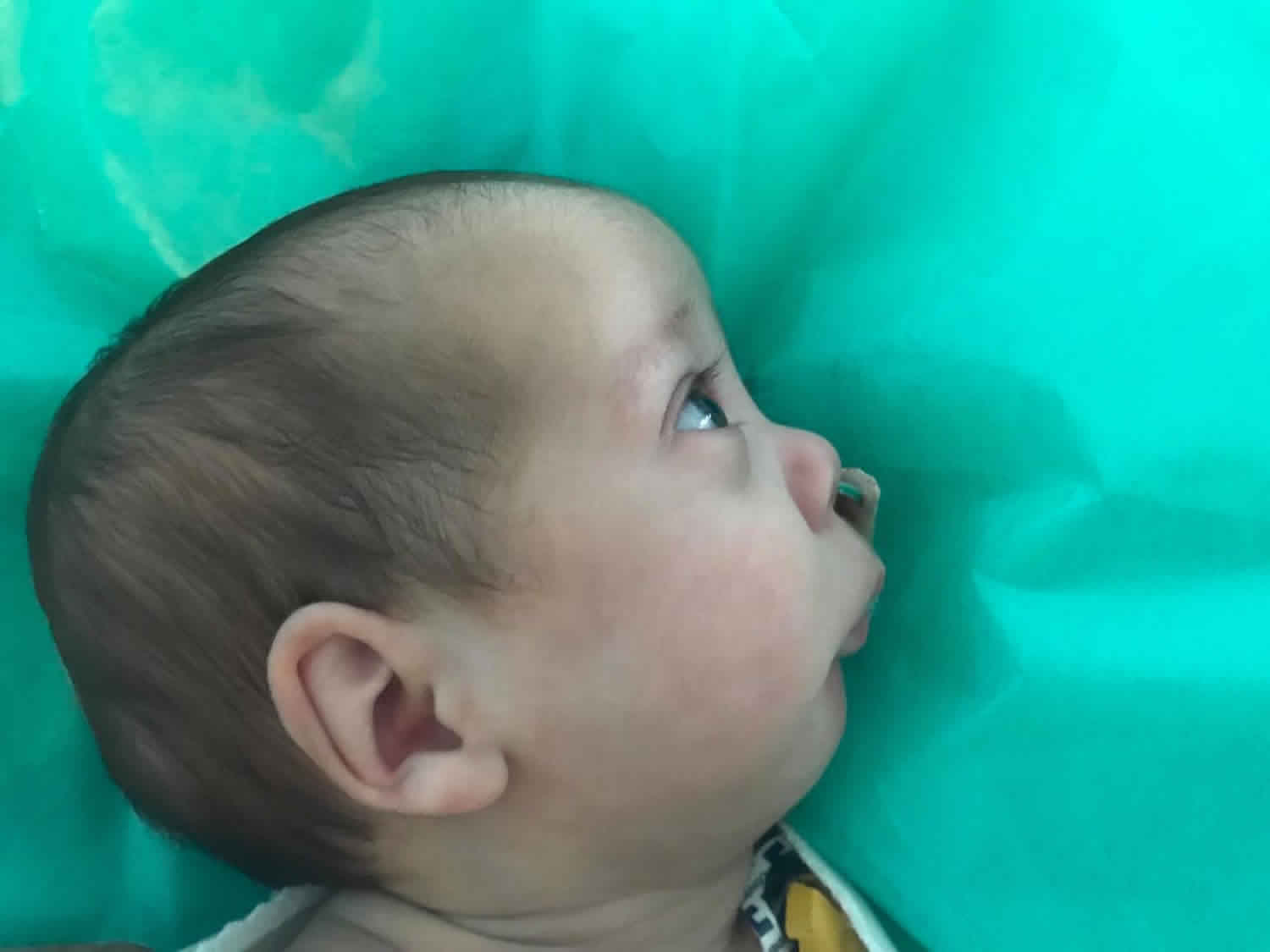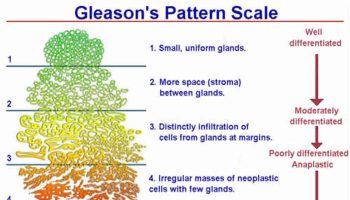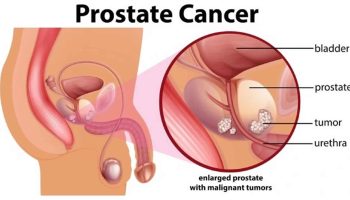Micrognathia
Micrognathia is the medical term for an undersized jaw, small lower jaw, small mandible or mandibular hypoplasia. Micrognathia can occur in isolation, but it may also be present along with other birth defects in numerous syndromes, including cleft lip, cleft palate, Pierre Robin sequence or syndrome, Stickler’s syndrome, Beckwith-Wiedemann syndrome, hemifacial microsomia, Treacher Collins syndrome and others 1. Retrognathia is a mandible that is displaced posteriorly (although not necessarily small) with respect to the maxilla. Most fetuses who are diagnosed with micrognathia by prenatal ultrasound imaging have a combination of these two disorders 2. Agnathia (otocephaly) is complete or almost complete agenesis of the mandible, with the temporal bones rotating medially; this results in the ears being horizontal and adjacent to each other or even fused in the expected location of the mandible. This extreme form of micrognathia is very rare 2.
Sometimes babies are born with micrognathia. Micrognathia may interfere with an infant’s feeding and breathing. For example, infants with micrognathia may need special nipples and positioning in order to feed properly. Outcomes for children with micrognathia are generally good, but can vary depending on the severity of the condition.
Symptoms of micrognathia can vary from child to child but may include:
- Apneic spells (a temporary stop in breathing)
- Feeding difficulties including prolonged feeding, inability to feed, and poor weight gain
- Noisy breathing
- Poor ability to sleep
In rare case, parents will report that their child turns blue (cyanosis) when feeding or sleeping due to breathing difficulties.
Micrognathia can be caused by certain inherited disorders and syndromes.
Micrognathia can cause the teeth not to align properly 3. This can be seen in the way the teeth close. Often there will not be enough room for the teeth to grow.
Children with micrognathia should see an orthodontist when the adult teeth come in. Because children may outgrow micrognathia, it often makes sense to delay treatment until a child is older.
Micrognathia often corrects itself during growth. The lower jaw may grow a lot during puberty.
Micrognathia causes
Micrognathia can appear in infants by itself or as part of a syndrome (where more than one body system is involved) such as cleft lip or cleft palate. The cause of micrognathia is often unknown but can be caused by an underlying genetic condition especially if the child has other anomalies.
Micrognathia may be part of other genetic syndromes, including:
- Cri du chat syndrome
- Hallerman-Streiff syndrome
- Marfan syndrome
- Pierre Robin syndrome or Pierre Robin sequence
- Progeria
- Russell-Silver syndrome
- Seckel syndrome
- Smith-Lemli-Opitz syndrome
- Treacher-Collins syndrome
- Trisomy 13
- Trisomy 18
- XO syndrome (Turner syndrome)
A syndrome may be inherited (passed down from the parents) or come about spontaneously.
Micrognathia symptoms
Along with a small jaw, infants may have trouble feeding, poor weight gain, failure to thrive (when children begin to fall off their growth curve), difficulty breathing and short periods of temporarily “ stopping to breathe (apnea)” during sleeping. This is called obstructive sleep apnea.
The airway is at the most risk for blockage at night when all the muscles are relaxed. When a child’s tongue is in a backward position due to a small jaw, his or her attempts to breath when sleeping can be met with partial or complete blockage. It occurs in about 2% of children.
Obstructive sleep apnea causes decreases in the blood’s ability to carry oxygen to the developing organs, so it can interfere with development. In children with obstructive sleep apnea and micrognathia, surgical treatment of the airway can be an emergency.
Symptoms of micrognathia can vary from child to child but may include:
- Apneic spells (a temporary stop in breathing)
- Feeding difficulties including prolonged feeding, inability to feed, and poor weight gain
- Noisy breathing
- Poor ability to sleep
In rare case, parents will report that their child turns blue (cyanosis) when feeding or sleeping due to breathing difficulties.
Micrognathia diagnosis
Your baby’s doctor will do a physical exam and may ask questions about the problem. Some of these may include:
- When did you first notice that the jaw was small?
- How severe is it?
- Does the child have trouble eating?
- What other symptoms are present?
During the physical exam, doctors look at:
- The relationship between your child’s tongue and lower jaw
- If your child has a cleft palate
- If your child has any facial asymmetries
- The relationship of your child’s upper jaw to their lower jaw
- Presence of a tongue tie (lingual frenulum)
- The overall health of your child
The following tests may be performed 4:
- Dental x-rays
- Skull x-rays
- If the child can tolerate it, a sleep study (polysomnogram) is done to see how bad his or her airway is obstructed. Polysomnogram measures your child’s breathing, brain stimulation, heart function, and oxygenation levels during sleep. If the results are severe, then a formal airway evaluation by the pediatric ENT is done in the operating room to assess the anatomy of the upper airway.
Depending on the symptoms, a child may need to be tested for an inherited condition that may be the source of the problem. The child may need surgery or devices to correct tooth position.
Genetic evaluation
Diagnostic testing with chromosomal microarray analysis should be offered when significant micrognathia is detected, particularly if there are additional features that are suggestive of a syndromic diagnosis. If a common aneuploidy syndrome is suspected, karyotype analysis or fluorescence in situ hybridization, with reflex to chromosomal microarray analysis, is a reasonable approach. Micrognathia can be inherited; however, a de novo variant is common with severe micrognathia. If there are additional anomalies, consanguinity, or a family history of a specific condition, gene panel testing or exome sequencing is sometimes useful because chromosomal microarray analysis does not detect single-gene (Mendelian) disorders. If exome sequencing is pursued, appropriate pretest and posttest genetic counseling by a provider who is experienced in the complexities of genomic sequencing is recommended 5. After appropriate counseling, cell-free DNA screening is a reasonable option for patients who decline diagnostic evaluation if a common aneuploidy syndrome is suspected. If micrognathia is isolated, evaluation of both parents is indicated because mild micrognathia can be a constitutionally inherited variant 6.
Micrognathia treatment
Early diagnosis and ongoing monitoring help with a multi-disciplinary team of specialists will determine the best time to medically or surgically intervene. If your baby has micrognathia, you may meet with:
- A pediatric otolaryngologist (ENT)
- A craniofacial plastic surgeon
- A pediatric geneticist
- A pediatric pulmonologist
Most children with micrognathia are able to be treated without undergoing surgery. Most infants with micrognathia can be managed by placing the baby on the stomach or side to sleep and feeding the baby in an upright position. Occasionally the baby may need a special tube inserted through the infant’s nose (nasopharyngeal tube) which opens the air passages or special accommodations for feeding. For infants who cannot be managed conservatively, a number of surgical procedures are available.
Non-surgical therapies
Non-surgical therapies to treat micrognathia include:
- Prone positioning — If your child sleeps on his stomach, the positioning thrusts his tongue base forward and clear his airway.
- Nasopharyngeal airways — This flexible tube with a flared end can be inserted into your child’s nostril and into the nasal passageway to create an open airway.
- Non-invasive positive pressure ventilation, such as CPAP (continuous positive airway pressure) or BiPAP (Bi-level positive airway pressure) that is managed by pulmonology for obstructive sleep apnea.
If these minimally-invasive measures do not work, your child may require surgery.
Micrognathia surgery
Surgical treatments for micrognathia include:
- Tongue-lip adhesion procedure, in which the base of your child’s tongue is tied to the lower jaw closer to the chin, effectively moving the tongue-base forward to clear the airway.
- Mandibular distraction osteogenesis (MDO), which makes the lower jaw larger by slowly lengthening the lower jaw bone and relieving airway obstruction.
- Tracheostomy, which creates an opening though the neck into the trachea to bypass the airway obstruction caused by a small jaw. This procedure is only rarely performed to treat micrognathia.
Mandibular distraction osteogenesis
Mandibular distraction osteogenesis is a surgical procedure that makes the lower jaw larger by slowly lengthening the lower jaw bone. The surgeon makes cuts on both sides of the lower jaw and attaches turning devices which expand the space in the bone cut. By turning the devices, the jaw moves forward (and with it, the tongue). The airway will then get bigger, and within a couple of weeks from the surgery, the breathing/sleeping problem will be improved.
Risks for mandibular distraction osteogenesis surgery include damage to tooth buds, sensory nerve damage, facial nerve damage, relapse of the original condition, and infection. After 6 weeks, the new bone has formed and the devices are removed. Usually, the child can go home during this period of bone formation. Additional benefits of mandibular distraction osteogenesis are improved feeding, decreased reflux, and avoidance of a permanent breathing tube called a tracheostomy.
Follow up
Regardless of whether or not a child undergoes surgery as an infant, he or she will need to be followed for:
- Jaw growth
- Dental (tooth) development
- Lower lip sensation
- Airway health
Sometimes, a second (or even first) mandibular distraction osteogenesis surgery is needed during childhood if breathing and sleep apnea problems persist. Many children born with micrognathia will eventually need orthodontic care, as well. Some eventually require corrective jaw surgery after growth is complete in adolescence.
Micrognathia prognosis
Micrognathia prognosis depends on the final syndromic diagnosis. Outcomes for children with micrognathia are generally good, but can vary depending on the severity of the condition, how quickly it was diagnosed, and how it was treated. Additional surgeries may be necessary dependent upon your child’s jaw growth and development. Your child will require long term monitoring until they have reached skeletal maturity in adolescence. In some cases, the growth of the mandible can accelerate and normalize into adulthood.
Early diagnosis and ongoing monitoring help clinicians determine the best time to medically or surgically intervene to give your child the best long-term quality of life.
- Enlow E, Greenberg JM. Clinical manifestations of diseases in the newborn. In: Kliegman RM, St. Geme JW, Schor NF, Blum NJ, Shah SS, et al. eds. Nelson Textbook of Pediatrics. 21st ed. Philadelphia, PA: Elsevier; 2020:chap 119.[↩]
- Paladini D. Fetal micrognathia: almost always an ominous finding. Ultrasound Obstet Gynecol. 2010;35(4):377‐384. doi:10.1002/uog.7639[↩][↩]
- Hartsfield JK, Cameron AC. Acquired and developmental disturbances of the teeth and associated oral structures. In: Dean JA, ed. McDonald and Avery’s Dentistry of the Child and Adolescent. 10th ed. St Louis, MO: Elsevier; 2016:chap 3.[↩]
- Resnik R, Lockwood CJ, Moore TR, Greene MF, Copel JA, Silver RM. Imaging of the face and neck. In: Resnik R, Lockwood CJ, Moore TR, Greene MF, Copel JA, Silver RM, eds. Creasy and Resnik’s Maternal-Fetal Medicine: Principles and Practice. 8th ed. Philadelphia, PA: Elsevier; 2019:chap 23.[↩]
- International Society for Prenatal Diagnosis; Society for Maternal and Fetal Medicine; Perinatal Quality Foundation. Joint Position Statement from the International Society for Prenatal Diagnosis (ISPD), the Society for Maternal Fetal Medicine (SMFM), and the Perinatal Quality Foundation (PQF) on the use of genome-wide sequencing for fetal diagnosis. Prenat Diagn. 2018;38(1):6‐9. doi:10.1002/pd.5195[↩]
- Micrognathia. SMFM Consult Series, Volume 221, ISSUE 5, PB13-B15, November 01, 2019 https://www.ajog.org/article/S0002-9378(19)31095-6/fulltext[↩]





